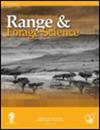Selection and evaluation of promising indigenous fodder trees and shrubs as supplemental diets for ruminant animals across different agroecological environments
IF 1.9
4区 环境科学与生态学
Q3 ECOLOGY
引用次数: 0
Abstract
AbstractThe aim of this study was to select and evaluate promising potential indigenous fodder trees and shrubs (IFTS) as supplemental feeds for ruminant animals. Through interviews with farmers and field inventories, 107 IFTS species were identified as ruminant feeds, from which 37 potential IFTS species were selected. The chemical composition and anti-nutritional factors of the selected IFTS were analysed. Among the 37 selected IFTS species, crude protein (CP) ranged from 83.3 to 230.5 (mean, 134.3) g kg−1 dry matter (DM); CP was greater than 80 g kg−1 DM in all selected species. Condensed tannin (CT) content varied from 2.57 to 210.91 g kg−1 (p < 0.05) among the selected species, of which 72% had < 40 g kg−1 DM, an amount that is tolerable for ruminants. Farmers’ preferences and the nutritive value of the selected fodder species were positively correlated (p < 0.05) for CP (0.61), organic matter digestibility (0.303) and metabolisable energy (0.25). Farmers’ preference ranking and the nutritive value of the plants were considered to select the top 14 IFTS, all of which had CP > 110 g kg−1, neutral detergent fibre (NDF) < 350 g kg−1, and CT < 40 g kg−1. Thus, the selected potential IFTS need further evaluation for their agronomic practice, biomass production and animal performance.Keywords: dry seasonfarmers’ preferenceindigenous fodderruminant animalssupplementary feed不同农业生态环境下反刍动物饲粮选择与评价
摘要本研究旨在筛选和评价有潜力作为反刍动物补充饲料的本土饲料乔灌木(IFTS)。通过对农民的访谈和实地调查,确定了107种IFTS作为反刍动物饲料,并从中选择了37种潜在的IFTS物种。分析了所选IFTS的化学成分和抗营养因子。在37个IFTS物种中,粗蛋白质(CP)在83.3 ~ 230.5(平均134.3)g kg−1干物质(DM)之间;所有被选物种的CP均大于80 g kg - 1 DM。所选物种的缩合单宁(CT)含量在2.57 ~ 210.91 g kg−1之间(p < 0.05),其中72%的DM < 40 g kg−1,这是反刍动物可以接受的水平。CP(0.61)、有机物消化率(0.303)和代谢能(0.25)与饲粮营养价值呈显著正相关(p < 0.05)。综合考虑农民的偏好排序和植株的营养价值,选择前14名的IFTS品种,CP均> 110 g kg - 1,中性洗涤纤维(NDF) < 350 g kg - 1, CT < 40 g kg - 1。因此,选定的潜在IFTS需要进一步评估其农艺实践、生物量生产和动物生产性能。关键词:旱季农民偏好;土饲;反刍动物
本文章由计算机程序翻译,如有差异,请以英文原文为准。
求助全文
约1分钟内获得全文
求助全文
来源期刊

African Journal of Range & Forage Science
ECOLOGY-ENVIRONMENTAL SCIENCES
CiteScore
4.00
自引率
14.30%
发文量
35
审稿时长
>12 weeks
期刊介绍:
The African Journal of Range & Forage Science is the leading rangeland and pastoral journal in Africa. The Journal is dedicated to publishing quality original material that advances rangeland ecology and pasture management. The journal aims to publish research of international importance from any region, but as an African journal, we are particularly interested in research from Africa and relevant to the continent. The Journal promotes both science and its application and authors are encouraged to explicitly identify the practical implications of their work. Peer-reviewed research papers and research notes deal primarily with all aspects of rangeland and pasture ecology and management, including the ecophysiology and biogeochemistry of rangelands and pastures, terrestrial plant–herbivore interactions (both domestic and wild), rangeland assessment and monitoring, effects of climate change on rangelands, rangeland and pasture management, rangeland rehabilitation, ecosystem services in support of production, conservation and biodiversity goals, and the identification and development of intensive and semi-intensive pasture and forage resources to meet livestock production needs. Articles highlighting transdisciplinary linkages among biophysical and social sciences that support management, policy and societal values are particularly encouraged. The Journal includes relevant book reviews and invited perspectives that contribute to the development of range and forage science. Letters to the editor that debate issues raised in the Journal are acceptable. The African Journal of Range & Forage Science is the official journal of the Grassland Society of Southern Africa.
 求助内容:
求助内容: 应助结果提醒方式:
应助结果提醒方式:


